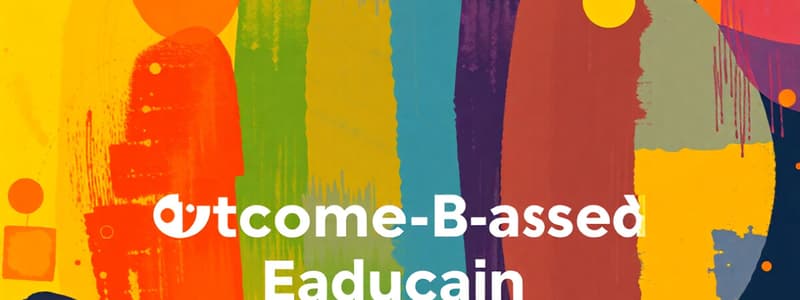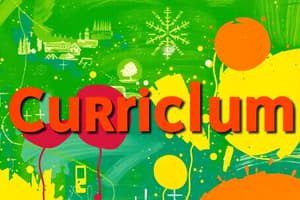Podcast
Questions and Answers
What is the primary objective of Problem-Based Learning (PBL)?
What is the primary objective of Problem-Based Learning (PBL)?
- To deliver content through lectures
- To develop fixed knowledge in students
- To minimize collaboration among students
- To help students develop flexible knowledge (correct)
In the context of PBL, what is the instructor's role?
In the context of PBL, what is the instructor's role?
- To act only as a strict authority figure
- To create a competitive learning environment
- To facilitate the learning process and provide support (correct)
- To provide all the answers directly to students
Which of the following is NOT a goal of Problem-Based Learning?
Which of the following is NOT a goal of Problem-Based Learning?
- Encouraging rote memorization of facts (correct)
- Developing effective collaboration skills
- Enhancing problem-solving skills
- Fostering self-directed learning
What is a characteristic of the spiral curriculum?
What is a characteristic of the spiral curriculum?
How does Community-Based Education engage students?
How does Community-Based Education engage students?
What is the primary focus of Outcome-Based Education (OBE)?
What is the primary focus of Outcome-Based Education (OBE)?
Which type of curriculum includes the intended educational objectives formally documented?
Which type of curriculum includes the intended educational objectives formally documented?
What does the term 'hidden curriculum' refer to?
What does the term 'hidden curriculum' refer to?
Which of the following best describes the operational curriculum?
Which of the following best describes the operational curriculum?
Which aspect does not define a curriculum?
Which aspect does not define a curriculum?
What is the crucial element of curriculum that outlines what and how students will learn?
What is the crucial element of curriculum that outlines what and how students will learn?
Which type of educational approach primarily focuses on inputs rather than student outcomes?
Which type of educational approach primarily focuses on inputs rather than student outcomes?
What aspect of a curriculum involves the environment in which learning occurs?
What aspect of a curriculum involves the environment in which learning occurs?
What is a key characteristic of the SPICES model's student-centered approach?
What is a key characteristic of the SPICES model's student-centered approach?
Which approach in the SPICES model prioritizes adaptability to student needs?
Which approach in the SPICES model prioritizes adaptability to student needs?
In the context of adult learning, what is meant by the principle 'readiness to learn'?
In the context of adult learning, what is meant by the principle 'readiness to learn'?
Which of the following represents a tension in the spectrum of educational strategies within the SPICES model?
Which of the following represents a tension in the spectrum of educational strategies within the SPICES model?
What does the 'systematic' approach in the SPICES model aim to achieve?
What does the 'systematic' approach in the SPICES model aim to achieve?
What impact did Abraham Flexner have on medical education?
What impact did Abraham Flexner have on medical education?
What is one of the principles of adult learning regarding the learners' experience?
What is one of the principles of adult learning regarding the learners' experience?
Which of the following best describes a community-based approach in the SPICES model?
Which of the following best describes a community-based approach in the SPICES model?
What is the primary goal of integrating different subject areas into a thematic curriculum?
What is the primary goal of integrating different subject areas into a thematic curriculum?
What does the SPICES curriculum model emphasize regarding assessment?
What does the SPICES curriculum model emphasize regarding assessment?
Which of the following is NOT an advantage of an integrated curriculum?
Which of the following is NOT an advantage of an integrated curriculum?
How does integration reflect the complexity of human health and disease?
How does integration reflect the complexity of human health and disease?
What is one of the main characteristics of curriculum integration as defined in the content?
What is one of the main characteristics of curriculum integration as defined in the content?
In what way does an integrated curriculum aim to improve student learning?
In what way does an integrated curriculum aim to improve student learning?
Why is it important for students to 'learn like a doctor and think like a doctor' in an integrated curriculum?
Why is it important for students to 'learn like a doctor and think like a doctor' in an integrated curriculum?
Which of the following best defines the term 'curriculum'?
Which of the following best defines the term 'curriculum'?
Flashcards are hidden until you start studying
Study Notes
Curriculum Definition
- Curriculum is a collection of courses and their content offered at a school or university for students to interact with, to achieve identified educational outcomes
- Curriculum is the set of instructional strategies teachers plan to use
- Curriculum includes what students learn, how they learn, how they are assessed, the learning environment and learning outcomes
Curriculum types
- Official Curriculum: Documented according to a common theme and successive grade levels with curriculum guides, course outlines, and lists of objectives.
- Operational Curriculum: What is actually taught by teachers and how it is communicated.
- Hidden Curriculum: Side effects of education, not explicitly taught but learned through classroom and social environments, such as values and beliefs.
Educational Models
- Outcome-Based Education (OBE): Focuses on measuring student performance (outcomes) and requires them to demonstrate they have learned required skills and content.
- Problem-Based Learning (PBL): Student-centered education using real-world problems to learn. Students identify what they know and don't know, and find ways to access new information to resolve the problem.
- Task-Based Learning: Classroom activity focuses on the task itself, using existing information to complete it.
- Core & Student Selection Components: An integrated, systems-based approach.
- Community-Based Education: Learners apply concepts, information, skills, and attitudes to local situations.
Curricular Structures
- Discrete Curriculum: Separate and isolated subjects.
- Linear Curriculum: Sequential learning, building upon previous knowledge.
- Pyramidal Structure: Hierarchical learning, progressing from basic to advanced concepts.
- Spiral Curriculum: Repeated study of a subject at different grade levels, increasing depth and difficulty with each iteration.
Educational Strategies
- SPICES Model: Framework for educational strategies with six dimensions (student centered/teacher centered, problem-based/information-oriented, integrated/discipline-based, community-based/hospital-based, elective/uniform, systematic/apprenticeship-based)
Principles of Adult Learning
- Need to Know: Adults require understanding of why they need to learn something before engaging in learning.
- Learner Self-Concept: Adults need to be responsible for their learning decisions.
- Role of Experience: Adults bring diverse life experiences to learning, which are valuable resources.
- Readiness to Learn: Adults are ready to learn what they need to cope effectively with life.
- Orientation to Learning: Adults are motivated to learn when they perceive it will help them perform tasks in their lives.
Integration in Medical Education
- Abraham Flexner's Recommendations: Led to medical curricula structured into preclinical and clinical medicine.
- Curriculum Integration: Meeting patients' needs by integrating disciplines into a thematic, systems-based curriculum.
Benefits of Integration
- Matching Curriculum Aims: Ensure coherence and relevance of educational goals.
- Achieving Higher Level Objectives: Promote deeper understanding and higher-order thinking.
- Avoiding Information Overload: Present information in a cohesive and organized manner.
- Making Learning Interesting & Effective: Engage students through real-world application and relevance.
- Motivating Students: Enhance student engagement and motivation.
Disadvantages of Integration
- Difficult to implement: Requires collaboration and coordination between disciplines.
- Time-consuming: May require curriculum development and restructuring.
- May lead to confusion for students: Lack of clear boundaries between disciplines.
- Requires different teaching approaches: Teachers need training and support to implement integrated teaching methods.
- May result in a lack of depth in specific disciplines: Focus on integration may lead to less in-depth coverage of specific subjects.
Studying That Suits You
Use AI to generate personalized quizzes and flashcards to suit your learning preferences.




